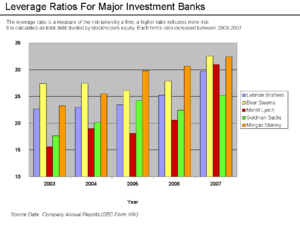 |
| Leverage Ratios of Investment Banks Increased Significantly 2003-2007 (Photo credit: Wikipedia) |
When we talk of the “financial crisis” we are referring to a huge list of financial failures and other problems which have occurred (some still ongoing) since 2007. Only a handful of these events are listed in the examples below, as there are far too many to cover in one blog post. Every nation taking part in the global economy has been affected by these problems to varying degrees.
Here are just a few of the problems the crisis has brought so far:
- Burst housing bubbles — This has already happened, or is still in progress, in the United States, Argentina, Britain, Netherlands, Italy, Australia, Canada, New Zealand, Ireland, Spain, Lebanon, France, Poland, South Africa, Israel, Greece, Bulgaria, Croatia, Norway, Singapore, South Korea, Baltic states, India, Romania, Ukraine and China to name a few. Housing bubbles cause a massive spike in housing prices, followed by a crash. This results in a high rate of foreclosures and evictions. Many trillions of dollars have been lost in property values — this loss is mainly felt by the homeowners. Many average citizens are left bankrupt or even homeless. However, financial institutions, the same ones that caused the bubble, are now benefiting from the low prices of homes now left vacant due to foreclosure. Average citizens pay the price, while financial institutions get even richer from the bubble they caused.
- Failed or acquired financial institutions — Numerous large banks, insurance companies and hedge funds have been rescued, acquired or bankrupted during the financial crisis. Just a few of the largest include: Merrill Lynch, Bear Stearns, Citigroup, Countrywide Financial, Lehman Brothers and AIG. Many smaller banks continue to fail in the U.S. and around the world.
- Government bailouts of corporations — A number of financial sector businesses (such as banks and insurance companies as mentioned in the last point) have been rescued or “bailed out” by governments around the world. In many cases, the top executives of these companies even received multi-million dollar bonuses for the time they spent guiding their company as it ran into the ground. Do the citizens, like you, get a bailout? No. You pay for the bailouts. In most cases, citizen’s tax dollars are used to fund the bailouts. If the rescued companies default on these loans, future generations (your children, then their children, etc.) will end up paying for these bailouts too.
- Failed retirement funds — Nations and corporations have been busy plundering, risking, and losing the retirement funds of their citizens and employees. In 2008 alone, retirement funds and pensions in a group of nations including the U.S., Japan, the United Kingdom and The Netherlands lost a combined $5 trillion due to the global financial crisis. Many workers nearing retirement age have had to postpone retirement plans or take a second job. Some have completely given up on the idea of retirement, having no choice but to keep working until they drop dead. This is especially hard on those who have watched their home’s value plummet or if one or more people in their household have become unemployed. In another example, Spain has quietly and aggressively plundered at least 90% of its social security fund, purchasing increasingly risky debt—its own debt—Spanish government bonds. The Spanish government is nearly bankrupt. It is on the brink of needing international financial aid, like Greece. Spain is among the most financially unstable of European nations. It seems likely their social security fund would have been safer if wagered on a coin toss.
- Rich are getting richer, middle-class are joining the poor — Here are a few figures (from the U.S.) to help put this in perspective… In 2010, the wealthiest 1% of Americans held 42% of all financial wealth in the U.S. The richest 10% controlled 85% of the wealth. The bottom 80% held just 5% of all U.S. wealth. This wealth gap continues to grow more extreme. (Note: These figures represent total net worth minus the value of one’s home). This phenomenon isn’t limited to the United States. In a bigger view, worldwide, the poorest 50% hold only 1% of global wealth.
- Rising unemployment -- Contrary to official government reports, we estimate that the real unemployment rate in the U.S. is now over 20%. This is getting very close to levels seen during the Great Depression of the 1930s. (Note: U.S. government statisticians attempt to hide the real level of unemployment by using new reporting methods which, for example, don’t include the long-term unemployed!). Looking to Europe in the critical 15-24 age group, unemployment recently reached 57.6% in Greece and 56.5% in Spain. We see this as a time-bomb, ready to explode without warning. Historically, high unemployment in this age group often leads to future economic instability and social upheaval. We are already seeing strong signs of both.
- Rising dependence on government assistance — In 2012, a record-setting 1 in 6 Americans were at, or below, the poverty level and receiving “food stamps”, a form of government assistance. Many nations have far higher levels of poverty brought on by the global crisis.
- Plus many more — The above list is just the tip of the iceberg. There are countless more examples of how the current global financial crisis has been impacting our world and our lives.









